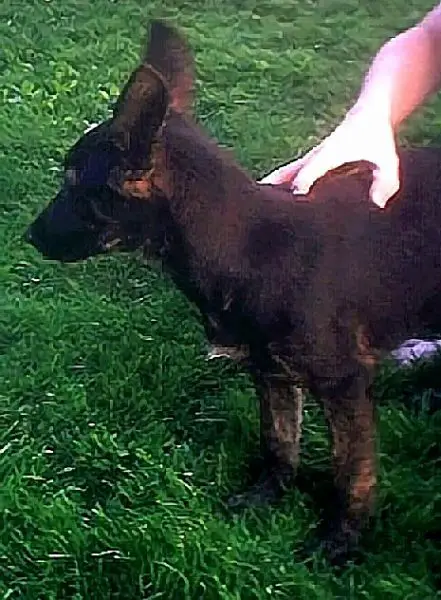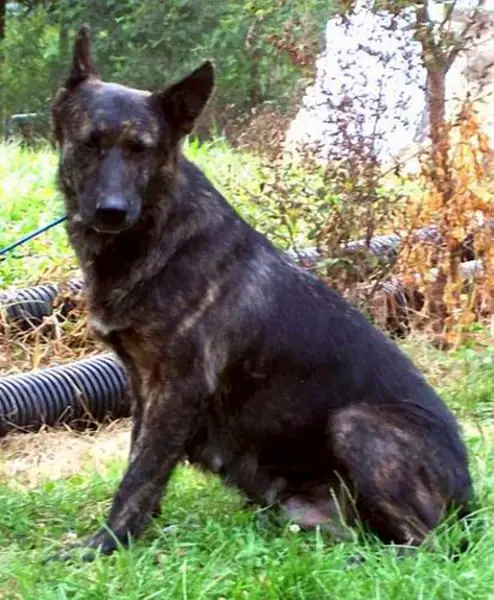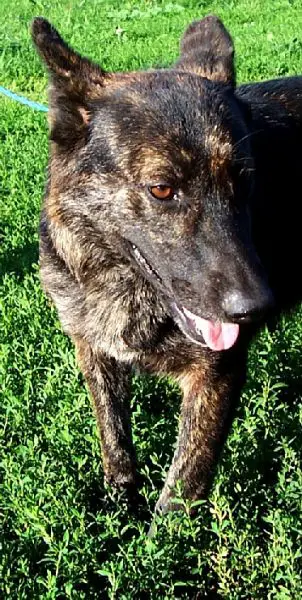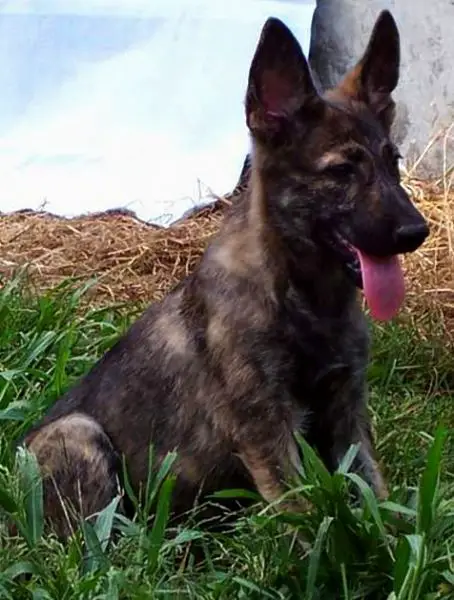
This is a placeholder text
Group text
by Siantha on 26 October 2012 - 02:10
i know thats what i said. but obviously i know nothing about what a german shepherd looks like and was refuzed a pedigree when i asked about it and the owner got quite offended when we asked if there was a possability of another dog getting in the mix. i figured i would post it on here. she said she was going to do a dna test but that none of us needed to know the results because she knows what he is.... then why did she ask what color he was :D ahh why do people breed when they dont know anything about their own breed.
by GSD2727 on 26 October 2012 - 03:10
Siantha - the whole thread on the FB page is ridiculous. The person with the puppies knows nothing about GSDs, breeding, she didnt even know what it meant to share the parents pedigree, she didnt know what sable was, she didnt know what bi color was, she also did not know that two males could breed a female in heat. I suspect she will not DNA the puppies, will sell them as "rare" colors and brag about it. Most on that page jumped on the bandwagon about how great and cute the puppies were and anyone who questioned it was mean lol Sad that there are such irresponsible people out there, but guess that is why people need to do their homework and research before buying a puppy.
by GSDGenetics on 07 December 2012 - 07:12
BRINDLE is a dominant mutation of the ground color from the typical relatively solid red, tan, cream, or silver ground color to the brindle ground color pattern. I've seen photos of a number of brindles. I also personally observed and photographed a dark black and red brindle bitch from puppyhood to adult. Brindle only affects the ground color. I believe that the mutation for brindle probably regularly occurs in the breed, but the only way a brindle GSD ever comes to the attention of serious GSD enthusiasts is if that brindle dog happens to be born in a litter owned by a knowledgeable breeder who knows for sure that the brindle dog's parents are registered purebred GSDs AND the breeder also RECOGNIZES the brindle for what it is. The black and red brindle bitch I personally observed and photographed was first described to me as a weird looking black pup. Most likely fanciers haven't generally tried to perpetuate brindle in the breed because a brindle agouti/sable isn't particularly attractive and brindle in a saddle pattern dog detracts from the illusion of greater substance and front and rear angulation provided by the contrast of the black saddle pattern against the normal ground color of a typical saddle patterned dog.
by Hundmutter on 07 December 2012 - 07:12
That is really very interesting, Genetics; thank you. I wonder if the reason that
brindle was rejected/culled out from the very earliest dogs was because of
your point re the illusion of 'lack of substance'. Still curious too about why a
dominant mutation is apparently much more likely to appear 'today' when it
has to all intents and purposes been 'absent' for decades; I take your point
about a lot of breeders/owners not knowing what they are looking at - but that
is not true of the entire GSD community ...
brindle was rejected/culled out from the very earliest dogs was because of
your point re the illusion of 'lack of substance'. Still curious too about why a
dominant mutation is apparently much more likely to appear 'today' when it
has to all intents and purposes been 'absent' for decades; I take your point
about a lot of breeders/owners not knowing what they are looking at - but that
is not true of the entire GSD community ...
by GSDGenetics on 07 December 2012 - 08:12
I don't believe brindle has been absent for decades. But for a brindle to be brought to the attention of serious GSD enthusiasts, that brindle has to be born into a litter owned by a knowledgeable and OPEN-MINDED breeder who is able to recognize it for what it is and also is willing to let other people know of its existence. Politically correct German or American show breeders are likely to cull a brindle puppy the same way they're likely to cull blues, whites, livers, or anything else their dogs produce that deviates too much from the breed standard.
While it's true that there are many people within the GSD community who are knowledgeable, open minded, and seriously interested in variations that occur within the breed, its a fact that there are many more people out there who breed their bitches to males who are convenient and free to use for reasons such as making some money selling puppies, wanting a puppy out of their own pet bitch, etc. Those kind of people usually aren't interested in learning about the breed and don't bother to get involved in the GSD community. Their puppies are usually sold or given away to other people who just want a pet GSD. Brindle pups born into these peoples litters are highly unlikely to ever come to the attention of anybody in the GSD community.
While it's true that there are many people within the GSD community who are knowledgeable, open minded, and seriously interested in variations that occur within the breed, its a fact that there are many more people out there who breed their bitches to males who are convenient and free to use for reasons such as making some money selling puppies, wanting a puppy out of their own pet bitch, etc. Those kind of people usually aren't interested in learning about the breed and don't bother to get involved in the GSD community. Their puppies are usually sold or given away to other people who just want a pet GSD. Brindle pups born into these peoples litters are highly unlikely to ever come to the attention of anybody in the GSD community.
by Hundmutter on 07 December 2012 - 09:12
Oh, too true, you are preaching to the converted on that !
What would you estimate the brindle occurance rates at ?
Do you think brindle would be much more likely to turn up in
the profit-making. odd colours, sector ? Wouldn't someone
who got one or more try to cash in on it, though ?
What would you estimate the brindle occurance rates at ?
Do you think brindle would be much more likely to turn up in
the profit-making. odd colours, sector ? Wouldn't someone
who got one or more try to cash in on it, though ?
by GSD Lineage on 07 December 2012 - 10:12
Here you huys go VA1 Brindle Trindle. I have not seen where it is written that the color was eliminated. But certainly it is not popular, desired or common.

1913 SGR Arno von der Eichenburg
German Shepherd Dog
Th color came through his mother and traces to Beowulf.
1913 SGR Arno von der Eichenburg 
German Shepherd Dog
 Male
Male
| Inserted 12.9 years ago | - | Father: VA1 Tell von der Kriminalpolizei |
| Registry: SZ 24876 | - | Mother: Diana von der Bloßenburg |
by GSDGenetics on 07 December 2012 - 12:12
I think the dog pictured at this thread
http://www.germanshepherds.com/forum/breed-standard/185960-not-your-typical-black-sable.html
may very well be a brindle.
The legs show a definite striped pattern. The shadings of the lighter ground color that so often shows through on the legs of a typical solid black are more diffused and usually more concentrated on the backs of the forelegs.
Compare the photos of the dog at the above link to the photos of the dark black and red/tan brindle below.

Pallette, bicolor brindle black & red/tan as a pup
.jpg)
Pallette as a puppy showing closeup- of head markings

Pallette, brindle bicolor black & red/tan as an adult
The above dog, as is typical of a spontaneous dominant mutation, was the only brindle pup in the litter. Her sire was saddle black and red, her dam was a solid black.

Brindle bi b/t head and front closeup

Agouti/sable brindle pup
My guess is that the fact that brindle detracts somewhat from the dog's expression, detracts from rather than enhances the appearance of angulation and substance, and also tends to give an illusion of less substance, may be at least two reasons why brindle hasn't ever really "caught on" with people who are fans of oddball colors.
http://www.germanshepherds.com/forum/breed-standard/185960-not-your-typical-black-sable.html
may very well be a brindle.
The legs show a definite striped pattern. The shadings of the lighter ground color that so often shows through on the legs of a typical solid black are more diffused and usually more concentrated on the backs of the forelegs.
Compare the photos of the dog at the above link to the photos of the dark black and red/tan brindle below.

Pallette, bicolor brindle black & red/tan as a pup
.jpg)
Pallette as a puppy showing closeup- of head markings

Pallette, brindle bicolor black & red/tan as an adult
The above dog, as is typical of a spontaneous dominant mutation, was the only brindle pup in the litter. Her sire was saddle black and red, her dam was a solid black.

Brindle bi b/t head and front closeup

Agouti/sable brindle pup
My guess is that the fact that brindle detracts somewhat from the dog's expression, detracts from rather than enhances the appearance of angulation and substance, and also tends to give an illusion of less substance, may be at least two reasons why brindle hasn't ever really "caught on" with people who are fans of oddball colors.
by eddyelevation on 01 January 2013 - 22:01
so cool .............that's what is so great about the german shepherd,they come in all sizes and colours................fantastic.............criteria #1 should always be temperamant and some form of working ability.
Contact information Disclaimer Privacy Statement Copyright Information Terms of Service Cookie policy ↑ Back to top




